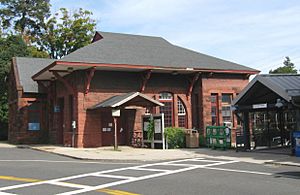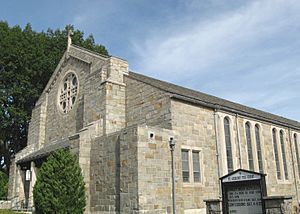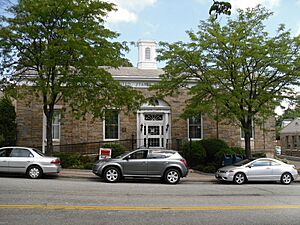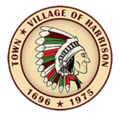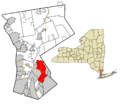Harrison, New York facts for kids
Quick facts for kids
Harrison
|
|||
|---|---|---|---|
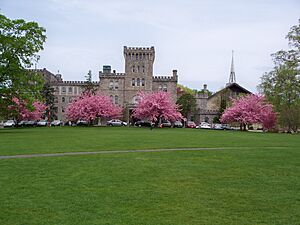
Manhattanville College in Purchase, a hamlet of Harrison
|
|||
|
|||
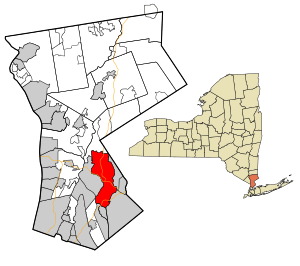
Location of Harrison, New York
|
|||
| Country | United States | ||
| State | New York | ||
| County | Westchester | ||
| Founded | 1696 | ||
| Town | March 7, 1788 | ||
| Town/village | 1975 | ||
| Named for | John Harrison | ||
| Government | |||
| • Type | Mayor–council government | ||
| Area | |||
| • Total | 17.44 sq mi (45.17 km2) | ||
| • Land | 16.77 sq mi (43.42 km2) | ||
| • Water | 0.67 sq mi (1.75 km2) | ||
| Elevation | 69 ft (21 m) | ||
| Population
(2020)
|
|||
| • Total | 28,218 | ||
| • Density | 1,683.05/sq mi (649.84/km2) | ||
| Demonym(s) | Harrisonite | ||
| Time zone | UTC−5 (Eastern (EST)) | ||
| • Summer (DST) | UTC−4 (Eastern (EDT)) | ||
| ZIP Code |
10528, 10604
|
||
| Area code(s) | 914 | ||
| FIPS code | 36-32402 | ||
| GNIS feature ID | 0977345 | ||
Harrison is a unique place in Westchester County, New York. It's both a town and a village at the same time!
Harrison is a New York City suburb. It is located about 22 miles northeast of Manhattan. In 2020, about 28,218 people called Harrison home.
Contents
History of Harrison
How Harrison Began: The 17th Century
Harrison was officially started in 1696. The British government gave a special document, called a patent, to John Harrison and three other people. A year before, they had bought land from local Native Americans. This land was above an old trail called Westchester Path. This trail went from Manhattan to Port Chester.
There's a fun story that John Harrison rode his horse for 24 hours to claim the land. The story says his horse didn't want to get its feet wet! But this is just a folk tale. The land near Long Island Sound had already been bought by settlers from Rye, New York.
The people of Rye were upset about the land grant to Harrison. They even joined the Colony of Connecticut for a few years. But in 1700, the King of England ordered Rye to rejoin the Colony of New York.
Growing Up: The 18th Century
The first people to live permanently in Harrison's Purchase, as it was called, arrived around 1725. Many early settlers were Quakers. They built a meeting house in the area now known as Purchase.
Harrison's Purchase was managed by the settlers of Rye for a while. Then, on March 7, 1788, it officially became a town. This happened because of a law passed by the New York State government.
Merritt's Hill in West Harrison was important during the Revolutionary War. It was the site of the Battle of White Plains. Some soldiers in the battle were from Harrison.
Changes and Growth: The 19th Century
In the 1830s, David Haviland lived in Harrison. He made and sold Haviland China in his New York City store. Today, there's a Haviland Street in Harrison's downtown area.
In 1867, Benjamin Holladay bought land that is now Manhattanville College. He built a large mansion called Reid Castle. He also built a chapel for his wife. The King and Queen of Siam even visited the castle in the 1930s.
The Metro-North Railroad's New Haven Line came through Harrison in 1848. This line connects Manhattan to Greenwich, Connecticut. The first train station in Harrison wasn't built until 1870. Before that, people had to wave down the train to get a ride! Harrison mostly avoided factories during the Industrial Revolution. Factories grew in nearby towns like White Plains and Port Chester.
Modern Times: The 20th Century
In 1929, the Hutchinson River Parkway was extended to Harrison. Also, a large farm called Sunnyridge Farm was sold and turned into a housing development. New streets were built, and homes were designed to be strong and easy to care for.
This new neighborhood attracted famous people. These included bankers, business leaders, and even a musical star named Louise Groody. The Great Depression slowed down building for a while. But more homes were built in the 1940s and 1950s.
In 1967, some residents of Purchase wanted their community to become a separate village. This was to stop large companies from building there. To prevent this, Harrison officials decided to make the town a "Town/Village." This way, Purchase couldn't legally become its own village. Harrison is still a "Town/Village" today.
John A. Passidomo was a mayor of Harrison for many years. He served from 1965 to 1983. He helped bring big companies like PepsiCo and MasterCard to Harrison. This area became known as Harrison's "Platinum Mile."
Here is a list of some of Harrison's supervisors and mayors:
- Alfred F. Sulla Jr. (1946–1955, 1958–1965)
- John Passidomo (1965–1983)
- Pat V. Angarano (1983–1990)
- Charles Balancia (1990–1994)
- Philip A. Marraccini (1994–1998)
- Ronald Bianchi (1998–2002)
- Stephen Malfitano (2002–2008)
- Joan Walsh (2008–2012)
- Ronald Belmont (2012–2022)
- Richard Dionisio (2022–present)
Geography of Harrison
Harrison is located about 22 miles northeast of Manhattan, New York City. The total area of Harrison is about 17.4 square miles. About 16.8 square miles is land, and 0.6 square miles is water.
The distance from Harrison Station to Grand Central Terminal in Midtown Manhattan is about 27 miles.
Harrison shares borders with several other towns. These include North Castle, White Plains, and Rye city. Major highways like I-95 and the Hutchinson River Parkway run through the town.
What is the Climate Like in Harrison?
| Climate data for Harrison, New York | |||||||||||||
|---|---|---|---|---|---|---|---|---|---|---|---|---|---|
| Month | Jan | Feb | Mar | Apr | May | Jun | Jul | Aug | Sep | Oct | Nov | Dec | Year |
| Mean daily maximum °F (°C) | 35 (2) |
39 (4) |
47 (8) |
58 (14) |
68 (20) |
77 (25) |
82 (28) |
80 (27) |
73 (23) |
62 (17) |
51 (11) |
40 (4) |
59 (15) |
| Mean daily minimum °F (°C) | 21 (−6) |
23 (−5) |
29 (−2) |
39 (4) |
49 (9) |
59 (15) |
64 (18) |
63 (17) |
55 (13) |
44 (7) |
36 (2) |
27 (−3) |
42 (6) |
| Average precipitation inches (mm) | 3.78 (96) |
3.10 (79) |
4.52 (115) |
4.40 (112) |
4.12 (105) |
4.25 (108) |
3.71 (94) |
4.16 (106) |
4.72 (120) |
4.41 (112) |
3.97 (101) |
4.32 (110) |
49.46 (1,258) |
| Source: The Weather Channel | |||||||||||||
Harrison experiences a climate with warm summers and cold winters. The average high temperature in July is about 82°F (28°C). The average low temperature in January is about 21°F (-6°C). The town receives a good amount of rain throughout the year.
Neighborhoods in Harrison
Harrison is shaped a bit like a figure-eight. The southern part is called Harrison or "downtown." The northern part includes the hamlets of Purchase and West Harrison.
West Harrison is a bit separated from the rest of the town. It's surrounded by hills, a lake, and highways. There's mainly one road, Lake Street, that leads into it. West Harrison has a park and community centers. It was also the site of a Revolutionary War battle.
The "downtown" area of Harrison is mostly residential. It has different types of homes. Harrison's middle school, Louis M. Klein Middle School, and Harrison High School are both located here.
Population and People
| Historical population | |||
|---|---|---|---|
| Census | Pop. | %± | |
| 1980 | 23,046 | — | |
| 1990 | 23,308 | 1.1% | |
| 2000 | 24,154 | 3.6% | |
| 2010 | 27,472 | 13.7% | |
| 2020 | 28,218 | 2.7% | |
| U.S. Decennial Census | |||
Harrison's population has grown over the years. In 1980, about 23,046 people lived there. By 2020, the population had increased to 28,218.
Who Lives in Harrison?
| Race / Ethnicity (NH = Non-Hispanic) | Pop 2010 | Pop 2020 | % 2010 | % 2020 |
|---|---|---|---|---|
| White alone (NH) | 21,133 | 18,780 | 76.93% | 66.55% |
| Black or African American alone (NH) | 563 | 745 | 2.05% | 2.64% |
| Native American or Alaska Native alone (NH) | 15 | 10 | 0.05% | 0.04% |
| Asian alone (NH) | 2,062 | 3,231 | 7.51% | 11.45% |
| Native Hawaiian or Pacific Islander alone (NH) | 8 | 4 | 0.03% | 0.01% |
| Other race alone (NH) | 69 | 182 | 0.25% | 0.64% |
| Mixed race or Multiracial (NH) | 420 | 864 | 1.53% | 3.06% |
| Hispanic or Latino (any race) | 3,202 | 4,402 | 11.66% | 15.60% |
| Total | 27,472 | 28,218 | 100.00% | 100.00% |
Harrison is a diverse community. In 2020, most residents were non-Hispanic white. There are also significant Asian and Hispanic or Latino populations. People of different backgrounds make Harrison a vibrant place.
Economy: Businesses in Harrison
Harrison is home to the main offices of several well-known companies. These include MasterCard and PepsiCo. Atlas Air and its branch, Polar Air Cargo, also have their headquarters in Purchase.
Texaco's large headquarters building was once in Harrison. After Texaco merged with Chevron, the building was sold to Morgan Stanley.
Arts and Culture
Harrison has several places that are important for their history and culture. These sites are listed on the National Register of Historic Places.
- The Hadden-Margolis House is a very old home. It was built around 1750, before the Revolutionary War.
- Stony Hill Cemetery is an African-American burial ground. It was used in the 1800s.
- The Post Office is a stone building. It was built in 1938 in a Greek-revival style. It even has a special mural inside from the Works Progress Administration.
Parks and Recreation
- Westchester Country Club is a private golf club in Harrison.
Education in Harrison
Public Schools
The Harrison Central School District runs the public schools. These include Harrison High School and Louis M. Klein Middle School. Both are in the downtown area.
The district also has four elementary schools:
- Purchase School serves Purchase and northern West Harrison.
- Preston School serves the Silver Lake area of West Harrison.
- Parsons School serves South Downtown.
- Harrison Avenue School serves the rest of "Downtown," Sunnyridge, Sterling Ridge/The Trails, and The Brentwood.
Private Schools
The Keio Academy of New York is a private high school. It is located in Purchase.
Colleges and Universities
In 2008, Fordham University opened its Westchester campus in West Harrison.
Transportation in Harrison
Roads and Highways
Several major roads and highways pass through Harrison:
 I-287 (Cross-Westchester Expressway)
I-287 (Cross-Westchester Expressway) I-95 (New England Thruway)
I-95 (New England Thruway) I-684
I-684 Hutchinson River Parkway
Hutchinson River Parkway NY 120
NY 120 NY 120A
NY 120A NY 127
NY 127
Bus Services
Harrison is served by the Bee-Line Bus System. This system provides bus routes throughout Westchester County.
Train Services
The New Haven Line of the Metro-North Railroad serves Harrison. You can catch a train at the Harrison station.
Airport Access
Westchester County Airport serves Harrison. Part of the airport is located in Purchase.
Fire Department
Harrison is protected by a mix of paid and volunteer firefighters. The Harrison Fire Department has both paid and volunteer members. The West Harrison Fire Department and the Purchase Fire Department are all-volunteer. Together, these departments help keep the town safe.
Notable People from Harrison
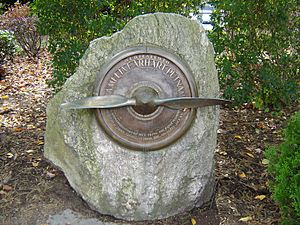
Many interesting people have lived in Harrison, including:
- Amelia Earhart (1897–1937), a famous aviator. She lived in Harrison when she was married to publisher George Putnam. There is a monument in Harrison to honor her.
- Kenneth Cole (born 1954), a well-known fashion designer.
- Tex Fletcher (1909–1987), a "singing cowboy" who was a recording artist, actor, and radio personality.
- Louise Groody, a musical star and actress who lived in Harrison.
- Mariano Rivera (born 1969), a famous pitcher for the New York Yankees.
- Gene Sarazen (1902–1999), a well-known American golfer.
Images for kids
See also
 In Spanish: Harrison (Nueva York) para niños
In Spanish: Harrison (Nueva York) para niños




